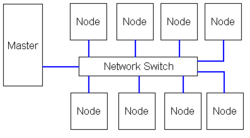Beowulf cluster: Difference between revisions
imported>Eric M Gearhart (Going to try to get this thing at Approval status. Started sectioning off the article) |
imported>Eric M Gearhart (testing multi-column reference list) |
||
| Line 28: | Line 28: | ||
==References== | ==References== | ||
{{reflist|2}} | |||
[[Category:CZ Live]] | [[Category:CZ Live]] | ||
[[Category:Computers Workgroup]] | [[Category:Computers Workgroup]] | ||
Revision as of 05:17, 11 April 2007

A Beowulf cluster is a group of personal computers linked together so that they act as one. This is known as parallel computing. This type of cluster is composed of a 'master' (which coordinates the processing power of the cluster) and usually many 'nodes' (computers that actually perform the calculations). The 'master' is typically a server, and "has more horsepower" than the individual nodes. The nodes in the cluster don't have to be identical, although to simplify deployment this is usually the case.
Usually the Beowulf 'nodes' are running Linux,[1] however this is not required, as both Mac OS X and FreeBSD clusters have been created.[2][3]
The nodes in a Beowulf cluster are networked into a small TCP/IP LAN, and have libraries and programs installed which allow processing to be shared among them.
The name Beowulf is derived from the main character in the Old English epic Beowulf.
Beowulf Development
Originally developed by Thomas L. Sterling and Donald Becker at NASA, Beowulf systems are deployed worldwide as "cheap supercomputers," chiefly in support of number crunching and scientific computing.
Common Beowulf clusters
There is no particular piece of software that defines a cluster as a Beowulf. Commonly used parallel processing libraries include MPI (Message Passing Interface) and PVM (Parallel Virtual Machine). Both of these permit the programmer to divide a task among a group of networked computers, and recollect the results of processing. It is a common misconception that any software will run faster on a Beowulf. The software must be re-written to take advantage of the cluster, and specifically have multiple non-dependent parallel computations involved in its execution.
References
- ↑ "Beowulf Project Overview" (Retreived 08-April-2007).
- ↑ "Mac OS X Beowulf Cluster Deployment Notes" (Retreived 08-April-2007).
- ↑ "A small Beowulf Cluster running FreeBSD" (Retreived 08-April-2007).